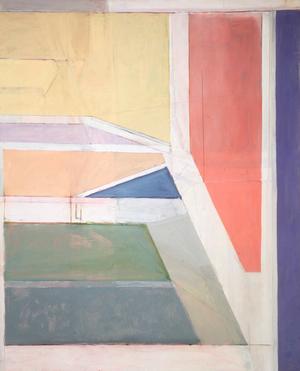October Off Ocean Park: Greeting Diebenkorn
 Gregg Chadwick
Gregg ChadwickOctober Off Ocean Park
72"x72" oil on linen 2006
My painting, "October Off Ocean Park" was painted in a series of starts, stops and absences. Major compositional elements were scraped down or painted over. I worked on the painting over a series of months then years. My artistic engagement with the work of Richard Diebenkorn helped me finish the piece. I knew I wanted to get the light of a Santa Monica evening into the work. But I wasn't quite sure how to pull it off. Not long ago I moved into a studio at the Santa Monica Airport, literally off Ocean Park Boulevard. I could walk out the door and see that evening light filtered through my memories of Diebenkorn's Ocean Park series.
 Richard Diebenkorn
Richard DiebenkornOcean Park No.27 100" x 81" oil on canvas 1970
Brooklyn Museum
Arthur C. Danto, in "Encounters and Reflections", writes at length on Diebenkorn's Ocean Park paintings:
"Ocean Park itself is a community in Santa Monica, where Diebenkorn traced a daily path between home and studio, but whether or not these works make the topical references to local landscape with which they are credited, they clearly are something more than abstractions with recurrent compositional motifs, cadences, pastel tonalities, scumbled fields and tapelike forms, and stunning juxtapositions of color swept on with masterful brushwork. Each of them, for example, displays the submerged record of its own realization, and so distinctive are the pentimenti in Diebenkorn's art that each painting carries within itself the visible history of the artist's search. The nearest parallel, perhaps, would be the great drawings of Rembrandt, in which certain crowded lines converge on the sought-after contour so that the drawing and its draw-ing are one, process and fulfillment inseparable. In my view, Diebenkorn's paintings are less about the bright skies and long horizons of Ocean Park than about the act of painting."
In Richard Diebenkorn's last years he moved back to Northern California from Los Angeles. Polar places of existence for many in the west. In Diebenkorn's work there is a difference in the light quality between the Ocean Park paintings created in Southern California and the more gestural and thicker pigmented works done in Northern California. It is too simplistic to ascribe these differences as solely about place. But I also find that my quality of vision differs as I view my paintings in these polar lights. Color seems to be more present, and perhaps more important, in my Southern California work. And space becomes expansive in my Southern California paintings as well. In San Francisco, the fog and the vertiginous landscape pull me close to the source.
As his health failed, Diebenkorn painted less but continued to create etchings at Crown Point Press in San Francisco. One morning on a walk from my Market Street loft, with a book by Robert Hughes in hand, I spotted Richard Diebenkorn leaning up against a BART entrance watching the cable car turnaround across Market Street. He was captivated by the movement of the conductors as they spun the car around on a giant wooden turntable. I stopped, leaned up against a wall, and flipped through Robert Hughes' "Nothing If Not Critical" until I reached his essay on Diebenkorn. I read slowly, pausing often to gaze up at Diebenkorn as he gazed at the forms moving across Powell Street. Eventually, I closed the book, walked over and thanked Richard Diebenkorn for his art and inspiration. He smiled and tears seemed to well up in his eyes, as he said "Thank you. I am glad that my work inspires you. Is your studio nearby?" I nodded and tried to say something "about the interplay between figuration and abstraction in his work." Diebenkorn was frail at this point and seemed to know that he didn't have much longer to live. I didn't want to take him away from his moment alone in the morning light on Market Street. I thanked him again and moved on. Richard Diebenkorn died soon after in 1993. The thought of Diebenkorn and his work is often with me.
 Richard Diebenkorn
Richard DiebenkornPortrait of Jane
John and Jane Fitz Gibbon Collection
*On May 12 at 6:00 p.m. at the new de Young Museum in San Francisco, Kathan Brown, Founding Director of Crown Point Press, will detail thirteen "magical secrets" about thinking creatively that she learned from working with artists in the etching studio over the past forty-four years. As part of the program Kathan Brown will play a videotape of Richard Diebenkorn working in the Crown Point Press Studios.



Comments